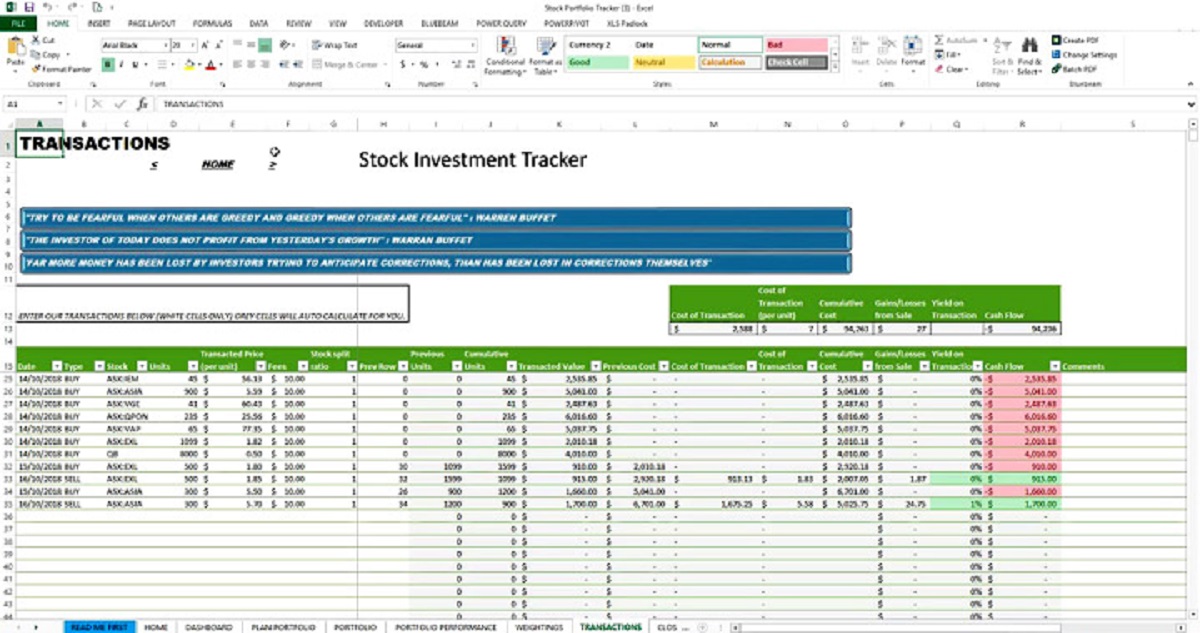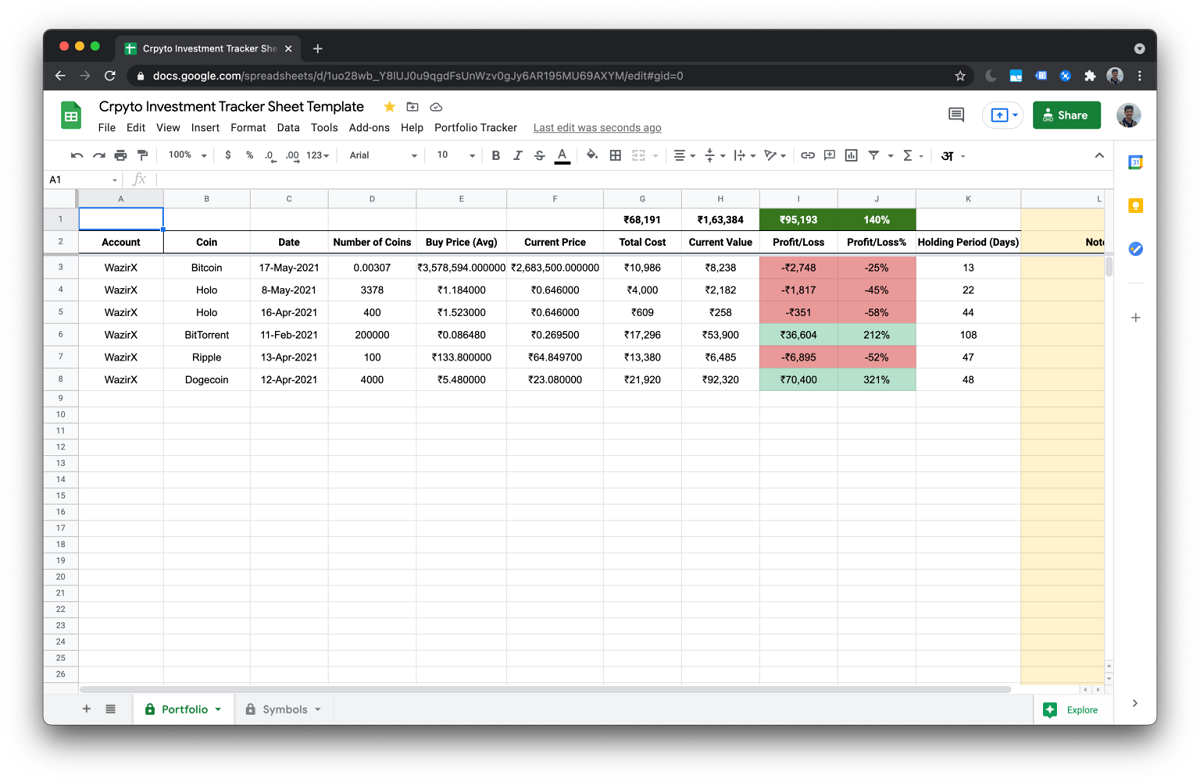Introduction
Welcome to our guide on how to track investments in Excel. As a savvy investor, it is crucial to keep a close eye on your investment portfolio to monitor its performance and make informed decisions. While many online platforms offer portfolio tracking tools, using Excel provides you with more flexibility and customization options.
In this article, we will walk you through the process of setting up an Excel spreadsheet to track your investments, importing investment data, formatting it, and calculating your portfolio value. Additionally, we will explore how you can track investment performance, analyze your portfolio, visualize your results, and set up alerts and notifications to stay updated on market changes.
Tracking your investments in Excel allows you to have a complete overview of your portfolio in one place, customized to suit your needs. Whether you’re a seasoned investor or just starting out, this guide will help you optimize your investment tracking process and gain valuable insights.
Before we dive into the details, it’s important to note that while Excel offers extensive capabilities, it’s always wise to cross-reference your data with other reliable sources and consult with a financial advisor if needed. Let’s get started on the journey to efficient investment tracking using Excel!
Setting Up Your Spreadsheet
Before you begin tracking your investments in Excel, it’s essential to set up a well-organized and structured spreadsheet. This will help you maintain clarity and ease of use as you input and analyze your investment data.
Start by opening a new workbook in Excel and create a new sheet dedicated to your investment tracking. Give this sheet a clear and descriptive name, such as “Investment Tracker.” This will make it easier to locate and navigate within your spreadsheet.
Next, create a list of column headers that will represent the different data points you want to track for each investment. Common column headers may include:
- Investment Name: Enter the name or symbol of your investment.
- Purchase Date: Record the date when you purchased the investment.
- Purchase Price: Enter the price at which you bought the investment.
- Quantity: Specify the number of units or shares purchased.
- Current Price: Track the current market price of your investment.
- Market Value: Calculate and display the current value of your investment.
You can customize these headers and add additional columns to suit your specific needs. For instance, if you’re tracking stocks, you may want to include columns for dividends, earnings per share, or any other relevant financial metrics.
Once you have set up your column headers, you can format the cells to display the appropriate data types. For example, you can set the “Purchase Date” column to display dates, the “Purchase Price” and “Current Price” columns to display currency, and so on. This will make it easier to input and interpret your investment data accurately.
In the next section, we will explore how to import your investment data into Excel, either manually or through online platforms or brokerage APIs, to streamline the tracking process and ensure data accuracy.
Importing Investment Data
Once you have set up the structure for your investment tracking spreadsheet, you can start importing your investment data. There are several ways to do this, depending on the source of your data and your preference for automation.
Manual Entry: The simplest method is to manually enter your investment data into the corresponding cells in Excel. This is suitable if you have a small number of investments or if you prefer a more hands-on approach. However, it can be time-consuming and prone to errors, especially if you have a large and diverse portfolio.
Online Platforms: Many financial platforms and investment tracking websites allow you to export your portfolio data in various file formats, such as CSV or Excel. Check if your investment platform provides this feature and use it to download your investment details. Then, you can import the downloaded file into Excel by opening it or using the “Import Data” functionality.
Brokerage APIs: Some brokerages offer APIs (Application Programming Interfaces) that allow you to retrieve your investment data directly into Excel. These APIs enable you to establish a connection between your spreadsheet and your brokerage account, which periodically updates your investment data automatically. This method offers real-time data syncing and eliminates the need for manual data entry. However, setting up API connections might require technical knowledge or assistance.
When importing your investment data into Excel, ensure that the data is properly mapped to the corresponding columns in your spreadsheet. Check for any discrepancies or formatting issues, especially if you are using external sources or APIs. It’s advised to review the imported data and make any necessary adjustments to maintain accuracy in your tracking.
In the next section, we will discuss how to format your investment data in Excel to enhance readability and make it easier to analyze your portfolio performance.
Formatting Your Investment Data
Formatting your investment data in Excel is crucial for better visualization and understanding of your portfolio. By applying formatting techniques, you can highlight key information, improve readability, and make it easier to analyze your investment performance.
Here are some formatting tips to consider:
- Conditional Formatting: Utilize conditional formatting to automatically highlight cells that meet specific criteria. For example, you can apply formatting to highlight investments that have gained or lost a certain percentage of value. This can help you quickly identify the best and worst performing investments in your portfolio.
- Data Validation: Use data validation to restrict data input to predefined formats or ranges. This ensures consistency and prevents errors. For example, you can set up data validation on the “Purchase Date” column to only allow dates within a certain range.
- Color Coding: Apply color coding to different data points or categories within your investment data. For instance, you can use different colors to represent different asset classes or sectors. This visual distinction makes it easier to analyze and compare investments at a glance.
- Number Formatting: Format your numeric values to display in a more reader-friendly format. For example, you can format currency values with the appropriate currency symbol and decimal places. Additionally, you can use percentage formatting to display investment returns.
- Headers and Borders: Use bold formatting and cell borders to visually separate headers and distinguish them from the data. This helps improve navigation and comprehension of your investment data.
In addition to these formatting techniques, consider grouping your investments and using collapsible sections or creating a summary table to provide an overview of your portfolio’s performance. These techniques can enhance the organization and accessibility of your investment data.
Remember, consistent formatting ensures that your investment data is presented in a clear and professional manner, making it easier for you to track and analyze your portfolio.
In the next section, we will explore how to calculate your portfolio value in Excel based on the investment data you have entered.
Calculating Your Portfolio Value
Calculating your portfolio value in Excel is a fundamental step in investment tracking. By determining the current value of your investments, you can assess your portfolio’s performance and make informed decisions. Here’s how you can calculate your portfolio value:
Step 1: Multiply Quantity by Current Price: In your investment tracking spreadsheet, create a new column titled “Market Value.” For each investment, multiply the quantity you own by the current price of that investment. This will give you the market value of each individual investment.
Step 2: Sum the Market Values: Once you have calculated the market value for each investment, create a cell where you can sum the market values of all your investments. You can use the SUM function in Excel to easily calculate the total value of your portfolio.
Step 3: Include Cash and Other Assets: If you have additional cash holdings or other non-traditional investments, include them in your portfolio value calculation. Add their values to the sum calculated in the previous step to get the comprehensive value of your entire portfolio.
Step 4: Update the Portfolio Value: To ensure your portfolio value is up-to-date, consider using manual input or automation methods, such as online data refresh or API integration, to update the current prices of your investments. This will give you a real-time and accurate picture of your portfolio’s value.
By regularly calculating your portfolio value, you can track its growth, monitor your investment performance, and make adjustments as needed. This method allows you to easily see how your investments contribute to your overall financial goals.
In the next section, we will discuss techniques for tracking investment performance in Excel, including tracking returns, measuring risk, and analyzing portfolio diversification.
Tracking Investment Performance
Tracking your investment performance is essential for evaluating the success of your investment decisions. Excel provides powerful tools to help you analyze and monitor the performance of your investments. Here are some techniques for tracking investment performance:
Tracking Returns: One of the key metrics for assessing investment performance is calculating the return on your investments. This can be done by comparing the initial purchase price with the current market value. In Excel, you can use the formula:
= (Current Value - Initial Investment) / Initial Investment
This will give you the return as a decimal value. You can format the cell as a percentage to see the return as a percentage.
Measuring Risk: Alongside tracking returns, it’s essential to evaluate the risk associated with your investments. Excel provides various statistical functions that can help measure risk, such as standard deviation and beta. These metrics provide insights into the volatility and correlation of your investments with the overall market.
Analyzing Diversification: Diversification is a strategy that reduces risk by spreading investments across different asset classes or sectors. Excel allows you to analyze the diversification of your portfolio by calculating the allocation percentages of different investments. You can use pie charts or bar charts to visualize the diversification of your investments.
Time-Weighted Returns: To accurately measure the performance of your portfolio over time, consider calculating the time-weighted return. This method takes into account the effect of cash flows and captures the true performance of your investments over different periods. Excel offers built-in functions like XIRR (extended internal rate of return) and TWRR (time-weighted rate of return) to calculate time-weighted returns.
Benchmark Comparison: Comparing your investment performance against a benchmark can provide valuable insights. You can incorporate benchmark data into your spreadsheet and use formulas to calculate the relative performance of your investments. This allows you to evaluate how your investments fare compared to a specific market index or industry average.
By regularly tracking investment performance, you can identify trends, evaluate the success of your investment strategy, and make informed decisions to optimize your portfolio. Excel offers the flexibility to customize your tracking methods and analyze performance metrics that are most relevant to your investment goals.
In the next section, we will explore how to analyze your investment portfolio in Excel, including assessing asset allocation, evaluating performance metrics, and identifying areas for improvement.
Analyzing Your Investment Portfolio
Analyzing your investment portfolio is essential for gaining insights into its composition, performance, and potential areas for improvement. Excel provides powerful analytical capabilities to help you evaluate and optimize your investment portfolio. Here are some techniques for analyzing your investment portfolio:
Assess Asset Allocation: Excel allows you to easily analyze the asset allocation of your portfolio. By calculating the percentage allocation of each asset class or sector, you can identify if your portfolio is properly diversified or if there is an overexposure to certain investments. Visualize your asset allocation using pie charts or bar charts to have a clear visual representation.
Evaluate Performance Metrics: Excel enables you to calculate various performance metrics to evaluate the performance of your investments. Some commonly used metrics include average return, standard deviation, Sharpe ratio, and alpha. These metrics provide insights into the risk-adjusted performance of your investments and help you compare them against benchmarks or industry standards.
Identify Winners and Losers: Use Excel to identify the best-performing investments in your portfolio, as well as those that are underperforming. By analyzing the returns of individual investments, you can make informed decisions regarding the allocation of your resources and potentially optimize your portfolio by reallocating funds from underperforming investments to stronger ones.
Track Income and Expenses: If you receive dividends or other income from your investments, Excel can help you track and analyze this data. By calculating the yield or income generated by each investment, you can evaluate its contribution to your overall portfolio. Additionally, monitoring expenses related to your investments, such as transaction fees or management fees, can provide a comprehensive view of the cost-efficiency of your portfolio.
Identify Risks: Excel offers various statistical functions that enable you to assess the risk associated with your portfolio. Calculating metrics like standard deviation, beta, and maximum drawdown can help you understand the volatility and downside risk of your investments. By identifying potential risks, you can take necessary steps to mitigate them and make informed decisions to protect and grow your portfolio.
By analyzing your investment portfolio with Excel, you can gain valuable insights into its performance and composition. These insights can guide you in making strategic investment decisions, optimizing your portfolio, and maximizing your returns.
In the next section, we will explore how to visualize your investment performance in Excel using charts and graphs, which can provide a more intuitive and visual representation of your portfolio’s growth and trends.
Visualizing Your Investment Performance
Visualizing your investment performance using charts and graphs in Excel can provide a more intuitive and engaging way to understand the growth and trends of your portfolio. By representing your data visually, you can quickly identify patterns, compare investments, and communicate your portfolio’s performance effectively. Here are some ways to visualize your investment performance:
Line Charts: Line charts are commonly used to track the value of investments over time. You can plot the historical performance of individual investments or the overall portfolio value. This allows you to see the growth or decline of your investments and identify any significant trends or patterns.
Bar Charts: Bar charts can be used to compare the performance of different investments or asset classes. You can create a bar chart to show the returns or market values of each investment, allowing you to identify the best performers and potential areas of improvement.
Pie Charts: Pie charts are useful for visualizing the asset allocation of your portfolio. You can create a pie chart to represent the percentage allocation of different asset classes or sectors. This provides a clear visual representation of how your portfolio is diversified and helps you identify any imbalances or overexposures.
Area Charts: Area charts are effective for illustrating the cumulative performance of investments over time. By plotting the cumulative returns or market values, you can gauge the overall growth of your portfolio and compare it with benchmarks or targets.
Heat Maps: Heat maps can be used to display the performance of investments across different time periods or metrics. By using color gradients, you can quickly assess the performance of investments and identify outliers or trends.
Scatter Plots: Scatter plots are helpful for analyzing the relationship between different investments. You can plot the returns of two investments and explore whether there is a correlation or divergence in their performance. This can provide insights into diversification and the potential benefits of combining different investments.
Excel offers a wide range of customizable chart and graph options, allowing you to tailor your visualizations to suit your specific needs. You can experiment with different chart types, colors, and formatting options to create visually appealing and informative representations of your investment performance.
In the next section, we will discuss how to set up alerts and notifications in Excel to stay updated on market changes and make timely decisions regarding your investments.
Setting Up Alerts and Notifications
Setting up alerts and notifications in Excel can help you stay informed about market changes and take timely actions regarding your investments. By receiving alerts for price movements, portfolio updates, or news events, you can effectively manage your investment strategy. Here’s how you can set up alerts and notifications in Excel:
Conditional Formatting: Excel’s conditional formatting feature can be used to automatically highlight specific cells or values that meet certain criteria. You can set up conditional formatting rules based on price thresholds or performance metrics. For example, you can highlight cells in red if the price of an investment drops below a certain level, alerting you to potential losses. This visual alert system enables you to quickly identify changes in your investments.
Data Validation and Error Trapping: Use Excel’s data validation feature to set up error alerts for incorrect or invalid data entries. You can create validation rules that prevent you from entering unrealistic values or data inconsistencies. This helps maintain the accuracy and integrity of your investment data, ensuring that you have reliable information for decision-making.
Formulas and Functions: Excel allows you to create custom formulas and functions that send alerts or trigger actions based on predefined conditions. For example, you can set up a formula that compares the performance of your investments against a benchmark and sends an email notification when there is a significant deviation. This way, you can stay updated on the relative performance of your investments.
External Data Connections: Excel enables you to establish external data connections to financial websites or APIs. By linking your spreadsheet to real-time market data or news feeds, you can receive updates and alerts directly within Excel. This ensures that you have access to the most current information and can respond promptly to market events.
Macro Automation: Advanced Excel users can leverage Visual Basic for Applications (VBA) to automate their alerts and notifications. VBA allows you to create custom macros that run specific actions based on predefined triggers. For example, you can develop a macro that sends an email notification when a specific investment reaches a certain price level. This automation streamlines the alert process and ensures you never miss critical updates.
Setting up alerts and notifications in Excel allows you to proactively monitor your investments and respond promptly to changing market conditions. By leveraging Excel’s built-in features and customizing them to your needs, you can stay informed and make timely investment decisions.
In the next section, we will conclude our guide and summarize the key points discussed throughout the article.
Conclusion
Tracking and managing your investments in Excel provides a versatile and customizable solution for monitoring and optimizing your portfolio. By setting up your spreadsheet, importing investment data, formatting it effectively, and calculating your portfolio value, you can establish a solid foundation for tracking your investments.
Moreover, Excel offers various tools and techniques for analyzing your investment performance, including tracking returns, measuring risk, and evaluating diversification. By regularly monitoring your portfolio’s performance, you can identify trends, make informed decisions, and take action to maximize your returns.
Visualizing your investment performance using charts and graphs in Excel allows you to gain insights at a glance and communicate your portfolio’s growth and trends effectively. By representing your data visually, you can quickly spot patterns, compare investments, and make strategic decisions to optimize your portfolio.
Additionally, setting up alerts and notifications in Excel ensures you stay updated on market changes and take timely actions. Whether through conditional formatting, data validation, external data connections, or custom macros, these alerts enable you to proactively manage your investments and respond promptly to important events.
Remember, while Excel provides a comprehensive platform for investment tracking, it’s crucial to cross-reference your data with reliable sources and seek professional advice when needed. Continuing to educate yourself about investment strategies and staying up to date with industry trends will empower you to make informed decisions and achieve your financial goals.
Now that you have learned how to effectively track and manage your investments in Excel, you are well-equipped to embark on a successful investment journey. Start implementing these techniques, adapt them to your specific needs, and watch your portfolio grow and thrive. Happy investing!

























